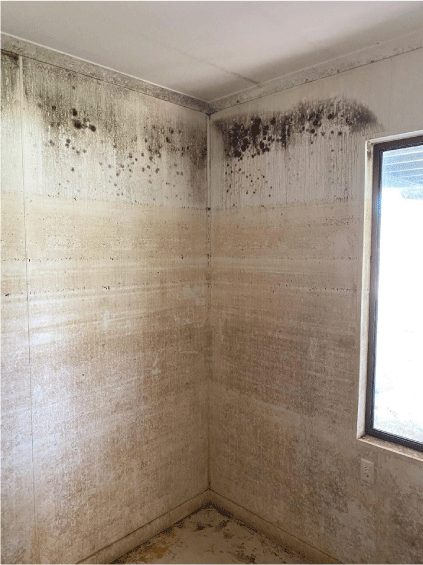Mould contamination of dwellings after flooding
Heike G. Neumeister-Kemp A * , Lara M. Kemp A and Natalie M. Tijsen AA

Dr Heike Neumeister-Kemp is the principal mycologist, founder and CEO of Mycotec. Heike is world renowned as a leading expert in the field of Environmental Mycology. Her passion for education and human rights helped to found the Indoor-Air-Quality Industry in Australia. Affectionately known as the ‘Mould Lady’, she is personally responsible for saving the homes, hospital’s and lives of countless people through her work. |

Lara Kemp is a science journalist at Mycotec. Lara is an innovative communicator, dedicated to enhancing public understanding of science and technology in the modern world. |

Natalie Tijsen is a Wildlife Ecologist with a BSc in Forensics. Natalie is a bright young scientist and new pioneer in the field of mycology. Her love of ecology and forensic background have combined to create the perfect forensic mycologist. |
Abstract
Australia’s sub-tropical coastline has been subjected to catastrophic flooding, congruent with a global trend of extreme weather events exacerbated by climate change. This study examined buildings post-flooding, to determine the impact of fungal contamination and evaluate remediation strategy success. Fungal species prevalence in association with wet building materials are outlined. Remediation methods found to be effective are highlighted. These findings support the necessity of establishing internationally recognised guidelines pertaining to mould contamination and remediation. This is particularly pertinent within the context of climate change. This research contributes to the scientific understanding of mycobiota in flood affected buildings, their health and safety implications and design of effective mitigation strategies.
Keywords: air cleaning, assurance program, climate change, climate disaster, education, exposure and health effects, extreme weather, flooding, mitigation (source control), mould, mycotoxin, policy, regulations, risk assessment, standards.
Background
Climate change has notably increased extreme weather events across the globe. Recently, Australia’s sub-tropical coastline which is uniquely positioned on the country’s Eastern-Shelf, has been subject to catastrophic atmospheric conditions, culminating in an extended 3-year La Niña phenomenon. This has led to several ‘1 in 100 years’ floods due to anomalies referred to as ‘rain-bombs’ reflecting a global trend in unprecedented extreme weather events. Juxtaposed with each summer’s prevailing bushfires, shock rainfall and mass flooding incidents into commercial and domestic buildings have devastated vast swaths of the country.1 Many affected areas are highly remote and comprise suburban housing, roads, crops and central waterways engulfed in blackwater. This has rendered access inordinately difficult, with many buildings either partially or completely submerged for hours to weeks on end (Fig. 1). The high number of dwellings affected following from these extreme weather events often results in a delayed timeframe for the assessment and remediation of buildings.
There are many ways that water can ingress into a dwelling following a disaster; however, two pathways predominate. The first being rain or hail events affecting buildings from above, by roof egress, and from the sides by wall egress, or gutter overflow. Secondly, surface water from rivers or oversaturated ground – that is no longer able to absorb any additional rainfall – often overflows into buildings from below. A lesser known yet prolific secondary ingress pathway is caused by prolonged extremely high relative humidity. This typically occurs due to a lack of ventilation or climate control inside a building due to power outages, resulting in condensation build up. Additionally, in many buildings flooded from below and left closed, water migrated up through the air and walls to proliferate in the upper floors.
It is well known that blackwater from flooding events carries a multitude of waterborne microorganisms including bacteria and viruses.2,3 It is lesser known that once water subsides and buildings begin to dry, another large group of microorganisms emerge. Fungi and mould rapidly colonise the surfaces and penetrate deep into buildings; subsequent human exposure to these contaminated environments has a host of well documented associated health risks.1,4–7 Although bacteria and viruses require moisture to survive, fungal propagation remains viable long past the point that moisture has subsided.8
High humidity or direct water inundation leads to an elevated water activity (Aw) within building materials. Levels above 75% water activity in any given building material will enable mould proliferation. This surface mould will eventually become airborne, potentially cross contaminating all accessible areas of a built environment. Simultaneously, outdoor air concentrations of fungal spores rise, increasing the opportunity for mould to cross-colonise indoors. This is due to general post flood conditions, including high relative humidity, in combination with an extra nutritional load comprising of debris, vegetation, dead animals, wet surface soils and other displaced materials.
For the purpose of this study, only fungal contamination of buildings was considered. There is an increased risk of fungal infections after flooding, causing potential long term health effects in humans and animals such as respiratory and systemic infections. Additionally, poisoning from mycotoxins poses a notable risk, especially in already stressed or immunocompromised individuals, who may be suffering from displacement and psychological distress.9
Mycotoxicosis is a lesser-known term for poisoning associated with exposures to mycotoxins.10 Mycotoxins are poisonous substances produced by fungi or mould as a natural defence mechanism against other fungi in the competition for nutrition. They can be toxic for humans when they are eaten, absorbed into the skin or inhaled.11 Even a small amount of mycotoxin can be damaging to human or animal health, and in extreme cases causing death. They have been linked with the development of neurodivergent disease.12 Mycotoxins have the potential for both acute and chronic health effects, through entering the blood stream and lymphatic system. Nausea, gastrointestinal disturbances and vomiting symptoms have been reported in relation to mycotoxin exposure.11,13,14
The fungal genera Aspergillus and Penicillium are often found in water damaged buildings wherein humans are primarily exposed to them. They have the ability to produce ochratoxin A (OTA), which is a nephrotoxin, immunotoxin and carcinogenic mycotoxin. This chemical is produced by moulds in both the Aspergillus and Penicillium genera.15
Citrinin (dihydrocitrinone, DHC) is a mycotoxin produced by the same group of fungi, Aspergillus, Penicillium and Monascus. Citrinin exposure can lead to nephropathy, due to its ability to increase permeability of mitochondrial membranes in the kidneys.16 Studies have linked citrinin exposure to a suppression of the immune response, and gastrointestinal system.17
More common health problems associated with exposure to building moisture and subsequent biological agents, affect the allergenic, respiratory, and immune system responses in humans. Increased incidences of respiratory symptoms such as asthma18 and allergies including hay fever, allergic rhinitis, sinusitis and eczema have been well documented.13,14,19,20 In addition, negative effects on, and suppression of, the immune systems health, and resilience regularly occur.21 Illness may result from a combination of factors present in water-damaged indoor environments, including, but not limited to, mould spores and hyphal fragments, mycotoxins, bacteria, bacterial endotoxins and cell-wall components.4 The mechanisms of illness include inflammation, oxidative stress, toxicity, infection, allergy and irritant effects of exposure. These effects have been linked to a heightened risk to the respiratory health of children.22,23
According to the Institute of Medicine of the National Academies health effects can arise from exposure to mould by-products such as volatile and semi-volatile organic compounds, mycotoxins and other components.24 Furthermore, substances produced by bacteria that grow in damp environments have been implicated in a range of biologic and health effects. These include inflammation of mucous membranes, respiratory effects, immunotoxicity, neurotoxicity, sensory irritation, skin toxicity and cancer-causing effects. There is evidence that some species of mould can lead to illnesses, such as hypersensitivity pneumonitis, allergic sinusitis, and allergic bronchopulmonary aspergillosis in susceptible individuals.25
Ritchie Shoemaker was the first to associate exposure to mould and water damaged buildings with Chronic Inflammatory Response Syndrome (CIRS). He demonstrated that the immune systems of individuals with certain genes, could not react appropriately to biotoxins as they would in healthy individuals.26 A recent study found negative effects on contextual memory, increased pain sensitivity and anxiety-like behaviour in mice when exposed to moulds found in water damaged buildings.27
A recent parliament inquiry into biotoxin exposure by the Australian government, has shown a clear link between mould exposure and various symptoms, including CIRS.28 Other studies on the long-term effects of mould and mycotoxin exposure suggest a link between mycotoxins and neurodegenerative diseases such as Alzheimer’s Disease, Parkinson’s Disease and Multiple Sclerosis.
As established, to avoid experiencing the negative health effects associated with mould exposure – as outlined in the literature – exposure to mould should be avoided. Therefore, after flooding events, when risk of mould exposure is heightened, appropriate assessments should be conducted to ensure the safety of individuals and buildings.
The authors of this paper were commissioned by insurers to ‘roll out’ an Insurance Assurance program and independently validate mould contamination and remediation efforts after flooding and rain bombs. In Declared Catastrophic (‘CAT’) events, such as ‘CAT 202’, which occurred in Townsville, Queensland, in 2019, and ‘CAT 781’, which occurred in the Murray–Darling River Basin, South Australia, several hundred thousand dwellings were simultaneously affected. Pre-inspecting every single dwelling prior to remediation was not possible, because of the sheer volume of buildings and a lack of infrastructure and resources. Therefore, a generic remediation and scope of works for each CAT event was established and issued to builders and restorers. This was based on, and factored in parameters, such as the nature of water inundation, its duration, and the relevant climatic zone.
Each dwelling is an individual case, affected by building materials, age, geography and response speed of restorers. As such, it was of outmost importance to establish whether the proposed generic scope of works was sufficient for the removal and mitigation of mould contamination at each building.
Post Remediation Verification (PRV) testing was conducted after a ‘strip out’ and subsequent remediation of dwellings, to ensure the efficacy of the nominated process. If the process was found to be ineffective or incomplete remediation was repeated based on the PRV results.
A final Clearance Testing (CLT) after reinstatement of the dwelling was conducted as legal protection for builders and remediators in addition to providing ‘peace of mind’ for owners and occupiers. The data from both the PRV and CLT was then used in the process of re-insuring dwellings that had been disaster affected.
Methods
A 3-part risk assessment for mould exposure was produced based on existing literature and practice, this included mould, moisture and relative humidity testing. Methods for cultural and non-cultural fungal air and surface sampling were used, to determine the number and speciation of mould present. Simultaneously a visual and moisture assessment was conducted and Temperature (°C), CO2 levels (ppm) and relative humidity (% RH) were measured.
Results
Results from the fungal analysis showed that Penicillium chrysogenum and Cladosporium cladosporioides are the most common fungal species found in the air of dwellings after floods, followed by Aspergillus versicolor to a lesser degree.
The results demonstrated that Chaetomium spp., Trichoderma spp., Acremonium spp. and Ulocladium spp. are highly common on damp building materials after flooding.
Analyses revealed that associated mycobiota exist on different building materials, associations were found between:
Acremonium spp., Penicillium chrysogenum, Stachybotrys spp. and Ulocladium spp. with plasterboard and wallpaper.
Aureobasidium pullulans, Cladosporium herbarum, Trichoderma spp. and yeasts with several types of wood (yellow–green tongue) and plywood.
Aspergillus fumigatus, A. melleus, A. niger, A. ochraceus, Chaetomium spp., Mucor racemosus and M. spinosus with concrete and other floor-related materials.
These results (Table 1) can be used to develop new and resistant building materials and relevant allergen extracts and to help focus research on relevant mycotoxins, microbial volatile organic compounds, and microparticles released into the indoor environment.
| Acremonium sp. | |
| Alternaria alternata | |
| Ascomycetes | |
| Aspergillus fumigatus | |
| Aspergillus niger | |
| Aspergillus flavus | |
| Aspergillus restrictus | |
| Aureobasidium sp. | |
| Basidiomycetes | |
| Botrytis sp. | |
| Bipolaris sp. | |
| Chaetomium sp. | |
| Cladosporium cladosporioides | |
| Curvularia sp. | |
| Dreschlera sp. | |
| Epicoccum sp. | |
| Fusarium oxysporum | |
| Fusarium solani | |
| Geotrichum sp. | |
| Monilia sp. | |
| Monoascus spp. | |
| Mucor spp. | |
| Nigrospora sp. | |
| Paecilomyces sp. | |
| Penicillium corylophilum | |
| Penicillium chrysogenum | |
| Penicillium brevicompactum | |
| Rhizopus sp. | |
| Stachybotrys sp. | |
| Stemphylium sp. | |
| Sporobolomyces roseus | |
| Trichoderma sp. | |
| Ulocladium sp. | |
| Yeast |
Congruent with the recommendations of both The Australian Mould Guideline23 and The Mould Workers Handbook,29 the consistent success of remediators is attributed to the physical agitation of surfaces by high‐efficiency particulate-absorbing (HEPA) filter vacuuming with horsehair brushes and wet wiping with a microfibre cloth. Use of either naturally brewed vinegar, alcohol or bio-enzymes had demonstratable positive outcomes as opposed to bleach, chlorine, oils, biocides and various branded ‘organic’ products that are demonstrated to be ineffective. Additional factors contributing to success include air scrubbing with a minimum of seven air changes throughout the remediation process followed by a gaseous treatment with hydrogen peroxide. Methods such as encapsulation with glues or paints, dry-ice blasting, fogging or spraying with various substances consistently failed PRV testing.
Conclusions
It can be concluded that there exists an associated mycobiota for different building materials much like there exists an associated mycobiota on different food types. The results presented can provide assistance to the building industry in the development, production and usage of materials that are less susceptible to fungal growth. Utilising glass fibre instead of wallpaper for example or manufacturing materials that consist of a non-toxic, fungus- or water-resistant composition such as coating plasterboards against Stachybotrys spp., would aid in limiting fungal growth within building after flooding events or prolonged relative humidity in turn decreasing the likelihood of mould exposure-related illnesses from occurring. With the notion of extreme changes in the world’s climate, standards and guidelines are necessary for the development and assurance of future building materials, infrastructure and remediation to be able to combat fungal growth, henceforth, there is a pressing need for an internationally accepted and recognised guidelines. Currently, the World Health Organization has guidelines regarding indoor air quality21; however, these are not easily applicable for Australian ecologies, therefore, standards for the remediation and assessment of mould pertaining specifically to Australia are needed.29,30 The data obtained from this assurance program will form the base for research at the newly found RAC1 Training Centre for Advanced Building Systems Against Airborne Infection Transmission at Queensland University of Technology (QUT) in Brisbane, Australia officially known as the THRIVE project.
References
1 Coulburn L, Miller W (2022) Prevalence, risk factors and impacts related to mould-affected housing: an Australian integrative review. Int J Environ Res Public Health 19, 1854.
| Crossref | Google Scholar | PubMed |
2 Furtak K et al. (2020) Prevalence of unclassified bacteria in the soil bacterial community from floodplain meadows (fluvisols) under simulated flood conditions revealed by a metataxonomic approachss. CATENA 188, 104448.
| Crossref | Google Scholar |
3 Masciopinto C et al. (2019) Human health risk assessment for the occurrence of enteric viruses in drinking water from wells: role of flood runoff injections. Sci Total Environ 666, 559-571.
| Crossref | Google Scholar | PubMed |
4 Andersen B et al. (2011) Associations between fungal species and water-damaged building materials. Appl Environ Microbiol 77, 4180-4188.
| Crossref | Google Scholar | PubMed |
5 Gravesen S et al. (1999) Microfungal contamination of damp buildings-examples of risk constructions and risk materials. Environ Health Perspect 107, 505-508.
| Crossref | Google Scholar | PubMed |
6 Hyvärinen A et al. (2002) Fungi and actinobacteria in moisture-damaged building materials – concentrations and diversity. Int Biodeterior Biodegradation 49, 27-37.
| Google Scholar |
7 Kildesø J et al. (2003) Determination of fungal spore release from wet building materials. Indoor Air 13, 148-155.
| Crossref | Google Scholar | PubMed |
8 Beuchat L R (1983) Influence of water activity on growth, metabolic activities and survival of yeasts and molds. J Food Prot 46, 135-141.
| Crossref | Google Scholar | PubMed |
9 Polizzi V et al. (2009) Jem spotlight: fungi, mycotoxins and microbial volatile organic compounds in mouldy interiors from water-damaged buildings. J Environ Monit 11, 1849-1858.
| Crossref | Google Scholar | PubMed |
10 Rotter BA et al. (1996) Toxicology of deoxynivalenol (vomitoxin). J Toxicol Environ Health 48, 1-34.
| Crossref | Google Scholar | PubMed |
11 Peraica M et al. (1999) Toxic effects of mycotoxins in humans. Bull World Health Organ 77, 754-766.
| Google Scholar | PubMed |
12 Nguyen VTT et al. (2022) The role of mycotoxins in neurodegenerative diseases: current state of the art and future perspectives of research. Biol Chem 403, 3-26.
| Crossref | Google Scholar | PubMed |
13 Gray M (2007) Molds and mycotoxins: beyond allergies and asthma. Altern Ther Health Med 13, 146-152.
| Google Scholar |
14 Gray MR et al. (2003) Mixed mold mycotoxicosis: immunological changes in humans following exposure in water-damaged buildings. Arch Environ Health 58, 410-420.
| Crossref | Google Scholar | PubMed |
15 Wang Y et al. (2016) Ochratoxin a producing fungi, biosynthetic pathway and regulatory mechanisms. Toxins 8, 83.
| Crossref | Google Scholar | PubMed |
16 Flajs D, Peraica M (2009) Toxicological properties of citrinin. Arh Hig Rada Toksikol 60, 457-464.
| Crossref | Google Scholar | PubMed |
17 Gao Y et al. (2020) The compromised intestinal barrier induced by mycotoxins. Toxins 12, 619.
| Crossref | Google Scholar |
18 Schütze N et al. (2010) Exposure to mycotoxins increases the allergic immune response in a murine asthma model. Am J Respir Crit Care Med 181, 1188-1199.
| Crossref | Google Scholar | PubMed |
19 Hedayati MT et al. (2007) Aspergillus flavus: human pathogen, allergen and mycotoxin producer. Microbiology 153, 1677-1692.
| Crossref | Google Scholar | PubMed |
20 Holme J et al. (2010) Culturable mold in indoor air and its association with moisture-related problems and asthma and allergy among Swedish children. Indoor Air 20, 329-340.
| Crossref | Google Scholar | PubMed |
21 World Health Organization (2009) WHO guidelines for indoor air quality: dampness and mould. https://www.who.int/publications/i/item/9789289041683
22 Garrett MH et al. (1998) Indoor airborne fungal spores, house dampness and associations with environmental factors and respiratory health in children. Clinical and experimental allergy. Clin Exp Allergy 28, 459-467.
| Crossref | Google Scholar | PubMed |
24 Institute of Medicine of the National Academies (2004) Damp Indoor Spaces and Health. The National Academies Press, Washington, DC, USA. 10.17226/11011
27 Harding CF et al. (2020) Mold inhalation causes innate immune activation, neural, cognitive, and emotional dysfunction. Brain Behav Immun 87, 218-228.
| Crossref | Google Scholar | PubMed |
28 Australian Government Department of Health and Aged Care (2020) Australian Government response to the House of Representatives Standing Committee on Health, Aged Care and Sport’s report on the Inquiry into Biotoxin-related Illnesses in Australia. https://www.aph.gov.au/DocumentStore.ashx?id=8d78bafa-5f57-4f98-87b3-6b61859eb667
30 Neumeister-Kemp HG et al. (2001) Alteration in indoor fungal levels via portable HEPA air filters in bedrooms of asthmatic children. Mycoses 44, 244.
| Google Scholar |
 Dr Heike Neumeister-Kemp is the principal mycologist, founder and CEO of Mycotec. Heike is world renowned as a leading expert in the field of Environmental Mycology. Her passion for education and human rights helped to found the Indoor-Air-Quality Industry in Australia. Affectionately known as the ‘Mould Lady’, she is personally responsible for saving the homes, hospital’s and lives of countless people through her work. |
 Lara Kemp is a science journalist at Mycotec. Lara is an innovative communicator, dedicated to enhancing public understanding of science and technology in the modern world. |
 Natalie Tijsen is a Wildlife Ecologist with a BSc in Forensics. Natalie is a bright young scientist and new pioneer in the field of mycology. Her love of ecology and forensic background have combined to create the perfect forensic mycologist. |



